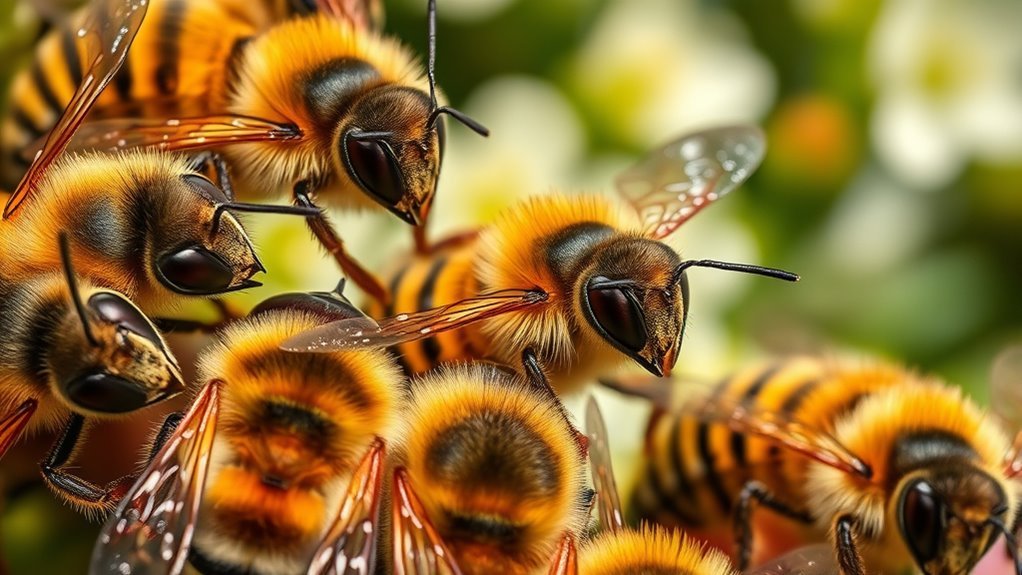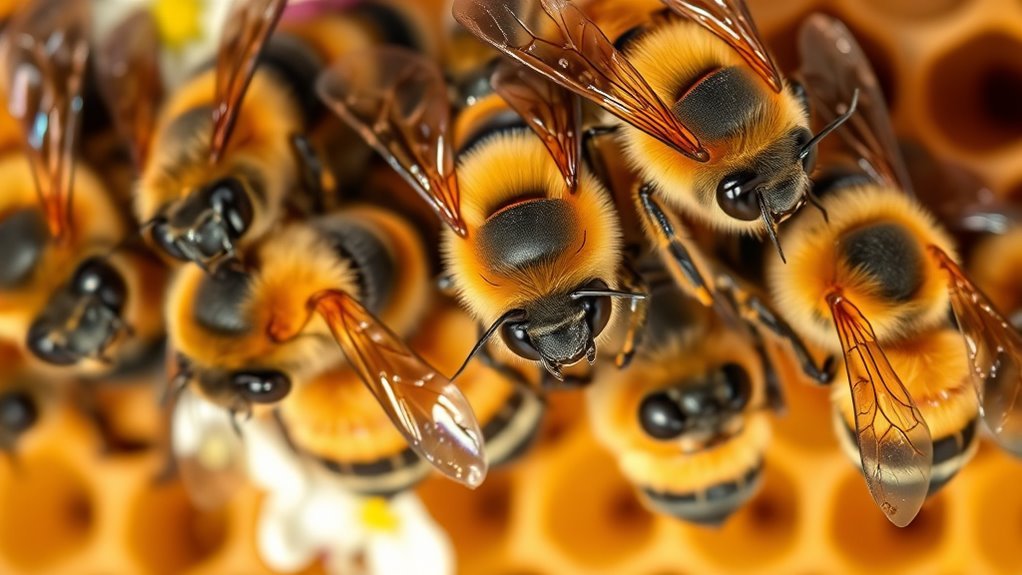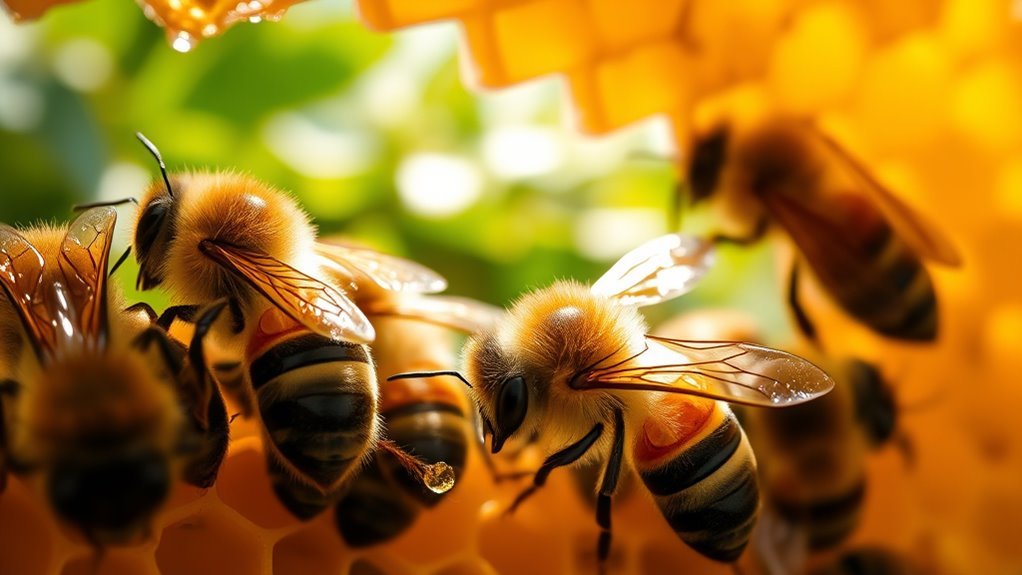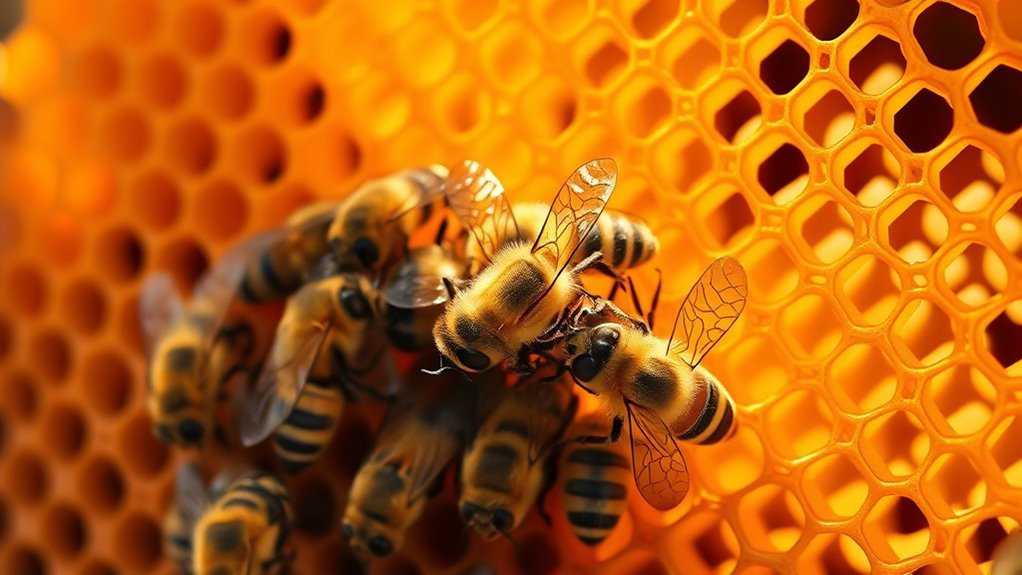Understanding drone bees is essential for managing your hive’s reproductive success and health. Drones, larger males with big eyes and no stingers, specialize in mating with virgin queens, ensuring genetic diversity. They don’t forage but engage in seasonal nuptial flights in spring and summer. Proper drone population control prevents resource strain and supports colony resilience. By mastering drone biology, behavior, and management, you’ll optimize your hive’s productivity and longevity as you explore their pivotal role in depth.
What Are Drone Bees?

Drone bees, or simply drones, are the male members of a honeybee colony, whose primary role is to mate with a fertile queen. Understanding drone bee history reveals their evolutionary specialization for reproduction, a role that’s both crucial and singular within the hive’s social structure. Contrary to drone bee myths suggesting drones are useless or lazy, their function is indispensable for genetic diversity and colony survival. You’ll find that drones don’t gather nectar or pollen; instead, they focus on mating flights during specific seasonal windows. Recognizing these facts frees you from common misconceptions and allows you to appreciate their strategic biological purpose. By grasping the true nature of drones, you gain insight into honeybee colony dynamics and the essential balance that sustains their freedom and proliferation.
Physical Characteristics of Drone Bees

To fully understand the role of male honeybees, you need to recognize how their physical structure supports their reproductive function. Drone anatomy is specialized: they possess larger, more robust bodies than worker bees, with considerably bigger eyes to detect queen flight patterns during mating. Their thorax is well-developed, housing powerful flight muscles essential for sustained flights. The wing structure in drones is distinct; their forewings and hindwings interlock for efficient aerodynamics, enabling swift, agile movement. Unlike workers, drones lack stingers and pollen-collecting adaptations, underscoring their singular reproductive purpose. Their abdomen is more rounded and contains reproductive organs but no wax glands. Understanding these anatomical details allows you to appreciate how drones are optimized for mating flights, emphasizing freedom in their function and movement within the hive environment.
The Role of Drones in the Hive

You’ll find that drone bees are specialized primarily for mating, equipped with anatomical features that promote reproductive success. Their role within the hive centers on fertilizing the queen during her nuptial flights, a critical function that guarantees colony genetics and survival. Understanding these reproductive responsibilities highlights why drones differ markedly from worker bees in both behavior and physiology.
Drone Bee Characteristics
Although drones lack the stingers and pollen-collecting abilities of worker bees, they play an essential reproductive role within the hive. When examining drone bee anatomy, you’ll notice their larger eyes and robust bodies, adaptations that facilitate locating and mating with queen bees during flight. Unlike workers, drones lack a barbed stinger, reflecting their non-defensive role. Their thorax is well-developed to support powerful flight muscles, vital for extended mating flights. Drone bee lifespan typically spans 8 weeks during active seasons, but they perish shortly after mating or are expelled before winter to conserve hive resources. Understanding these anatomical and lifecycle traits helps you manage your hive efficiently, ensuring drones fulfill their reproductive function without compromising colony sustainability or your beekeeping freedom.
Mating and Reproduction Roles
Building on their specialized anatomy and lifecycle, drones serve a singular purpose within the hive: reproduction. As a beekeeper, you’ll observe that drones engage in precise mating rituals, departing the hive to congregate in drone congregation areas. There, they compete to mate with virgin queens during nuptial flights, a critical aspect of the colony’s reproductive strategies. Their large eyes and powerful flight muscles are adaptations that enhance their ability to locate and successfully inseminate queens mid-air. Unlike worker bees, drones don’t participate in foraging or hive maintenance, emphasizing their exclusive reproductive role. Understanding these behaviors allows you to appreciate how drones contribute to genetic diversity and colony sustainability, ultimately shaping the hive’s freedom to thrive through natural selection and controlled reproduction.
How to Identify Drone Bees in Your Colony
To accurately identify drone bees in your colony, you’ll need to focus on their distinct physical traits such as larger eyes and robust bodies compared to worker bees. Observing their behavioral patterns, including flight activity and mating-related movements, provides additional confirmation. Finally, noting their typical positioning within the hive—often clustered near the brood or in designated drone cells—will help you distinguish them effectively.
Physical Characteristics Overview
Drone bees exhibit distinct physical traits that set them apart from worker bees and queens, making identification within your colony straightforward once you know what to look for. Examining drone anatomy, you’ll notice their larger, more robust bodies compared to the slender worker bees. Their heads are remarkably broader with huge compound eyes that nearly meet at the top, enhancing their visual capacity during mating flights. The thorax is well-developed, supporting a distinct wing structure; their wings are proportionally shorter and wider than those of workers, facilitating swift, agile flight. Additionally, drones lack a stinger and have a more rounded abdomen with visible segments. By focusing on these precise anatomical markers, you can confidently distinguish drones in your hive, granting you better control and understanding of colony dynamics without guesswork.
Behavioral Traits Identification
Recognizing the physical features of drone bees lays the foundation for understanding their unique behaviors within the colony. To identify drone behaviors, observe their flight patterns; drones engage in distinct mating flights, separate from worker foraging activities. Within the hive, drones exhibit minimal involvement in brood care or nectar processing, reflecting their specialized reproductive role. Their social dynamics position them primarily as reproductive agents, tolerated but not integrated into labor tasks. Drones’ tendency to cluster in specific hive areas and their interactions, often passive and non-aggressive, contrast markedly with worker bees’ active roles. By focusing on these behavioral markers—limited hive duties, specific flight activity, and social positioning—you’ll accurately identify drone bees and better appreciate their function within your colony’s complex social hierarchy.
Hive Positioning Insights
Several key areas within the hive consistently host drone bees, allowing you to distinguish them by their spatial distribution. Drones typically cluster near the periphery of brood frames, occupying larger drone cells. Applying precise hive orientation strategies enhances your ability to observe these patterns, as ideal hive locations encourage natural drone congregation. Positioning the hive entrance to face away from prevailing winds and direct sunlight can influence drone activity levels, making identification clearer. Additionally, drones tend to gather in upper hive sections during warmer periods, so monitoring these zones is essential. Understanding these hive positioning nuances empowers you to efficiently locate and manage drones, ensuring your colony’s reproductive dynamics remain balanced while granting you the freedom to intervene with minimal disruption.
Lifecycle and Behavior of Drone Bees
Although often overshadowed by worker bees and queens, the lifecycle and behavior of male honeybees—known as drones—play an essential role in the reproductive success of the colony. When you observe drone development, you’ll notice it spans roughly 24 days, longer than workers, and involves distinct stages: egg, larva, pupa, and adult. Their primary function centers on mating rituals, where drones leave the hive to congregate in drone congregation areas, seeking virgin queens. Key behavioral traits include:
- Flight patterns: Drones perform expansive flights to maximize mating opportunities.
- Energy allocation: They prioritize reproductive activities over foraging or hive maintenance.
- Seasonal dynamics: Drones are produced mainly in spring and summer, reflecting colony reproductive cycles.
Understanding these factors lets you manage your hive’s reproductive potential effectively.
Managing Drone Bee Populations
When managing drone bee populations, you need to balance their essential reproductive role with the potential impacts on hive resources and health. Implementing drone bee population control is imperative, especially since excessive drones consume significant honey and pollen without contributing to foraging or hive maintenance. Employ seasonal drone management strategies by reducing drone brood production in late summer and fall, aligning with the colony’s natural cycle to minimize resource strain before winter. You can achieve this by selectively removing drone comb or applying drone foundation frames that regulate drone brood patterns. Monitor drone numbers regularly to prevent overpopulation, which can lead to increased susceptibility to pests like Varroa mites. Mastering these technical controls guarantees your hive maintains energy and freedom to thrive without sacrificing reproductive capability.
The Importance of Drones for Mating
A drone’s primary function is to mate with a queen, ensuring the genetic diversity and health of the hive. As a beekeeper, understanding drone mating strategies is vital because it directly impacts colony resilience and adaptation. Drones participate in complex mating flights, where:
- Multiple drones compete to inseminate a single queen, promoting genetic diversity.
- Successful mating occurs in drone congregation areas, which are essential for natural selection.
- Genetic diversity achieved through these strategies reduces disease susceptibility and enhances hive productivity.
Seasonal Changes and Their Impact on Drones
Understanding the mating behavior of drones offers insight into their life cycle, which is heavily influenced by seasonal variations. You’ll notice that seasonal fluctuations dictate drone population dynamics within the hive, primarily driven by climate effects such as temperature and daylight changes. In spring and early summer, warmer conditions and longer days stimulate drone production to maximize mating opportunities. Conversely, as autumn approaches and temperatures drop, drones are systematically expelled from the colony to conserve resources. These climate effects guarantee that the colony’s energy investment aligns with reproductive success. By recognizing how drones respond to seasonal cues, you can better predict their presence and role within your hive throughout the year, emphasizing the importance of environmental factors in managing drone populations effectively.
Best Practices for Supporting Healthy Drone Bees
Since drones play a critical role in the reproductive success of your hive, maintaining their health requires targeted strategies that address nutrition, environmental conditions, and disease prevention. Enhancing drone bee nutrition is essential; provide ample pollen and nectar sources rich in proteins and lipids. Regulating hive temperature precisely between 33°C and 36°C guarantees ideal drone development and sperm viability. Actively monitor for pathogens like Nosema and Varroa mites, implementing integrated pest management to safeguard drone longevity. Key practices include:
- Guaranteeing continuous access to high-quality forage to meet drone metabolic demands
- Maintaining stable hive temperature with adequate ventilation and insulation
- Routine screening and timely treatment for parasites and diseases affecting drones

